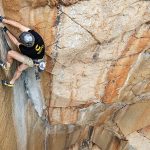Aside from Footstar and Foot Locker and its investors, its tough to find many people that like the deal announced last week that would see the worlds-largest-athletic-specialty-retailer become even larger after acquiring 353 Footaction stores out of bankruptcy.
Footstar, Inc. and its subsidiaries filed for Chapter 11 bankruptcy protection on March 2, 2004 and promptly liquidated all 88 Just for Feet stores and 75 under-performing Footaction stores. The company won approval just two week ago to auction off the remaining 353 Footaction stores through a process that required bids to be received last Monday with an auction scheduled for this past Friday, April 16. The final sales hearing to determine the winning bid was to take place this Wednesday, April 21.
All that went up in a puff of smoke last week as Foot Locker made a pre-emptive strike and acquired the 353 stores before they got to the auction. In a statement filed with the Bankruptcy Court on Wednesday, Footstar informed all bidders that the stores were pulled from the auction and the only assets that would be auctioned would be the closed JFF stores and the 75 closed Footaction stores. The good stuff, in effect, was yanked of the block.
The Foot Locker deal, worth $160 million in cash, is expected to keep the 353 stores alive under the Footaction banner. All store associates are expected to be retained, but corporate management has reportedly been given a 60-day warning of a closing notice. The deal now gives Foot Locker almost 4,000 doors worldwide under its various brands, with more than 3,300 of the stores located in the U.S. The companys closest rival, The Finish Line, operates 531 stores in the U.S.
The Finish Line, along with private equity firm Sun Capital, were said to be the only other bidders in the planned auction. As would be expected, the two are crying foul along with a host of other parties that dont like the looks of this deal. The Foot Locker action has now reportedly prompted FINL to make a bid for the entire lot of stores rather than the 190 stores we expected them to pick up in markets where they dont currently overlap.
While certain vendors are expected to benefit a great deal from the Foot Locker acquisition, the prospect of a stronger Foot Locker may also be making vendor management a bit uncomfortable.
The move would clearly make them a bit more unprofitable as well, as you can expect the sales that would have gone to Footaction will now cost them at least 2% to 3% more in discount.
As the April 21 sales hearing date looms a number of actions are being taken to kill — or at least delay or hinder — the deal.
Some of the original bidders are now rumored to be talking directly with the Unsecured Creditors Committee, which is dominated by Footaction vendors, in hope of cutting another deal that can be presented at the hearing. The other action may put more time on the clock for all parties as the Federal Trade Commission reviews the deal for violations of anti-trust law.
TheDEAL.com was reporting Friday that the FTC is “already receiving complaints” about the Foot Locker acquisition and that the deal “may not be as certain as a Michael Jordan slam dunk”.
The nature of the complaints is centered on how it would stifle competition in high-end athletic footwear.
TheDeal.com said the probe is “in its earliest stages” and could take “about two weeks” to decide whether to broaden the investigation. The FTC could overrule any BK Court decision in Foot Lockers favor and could to obtain a preliminary injunction in federal court to block the deal, which requires approval under the Hart-Scott-Rodino Antitrust Improvements Act of 1976. For this reason, the Court may decide to let the FTC investigation play out before it rules on the sale.
If the acquisition proceeds as planned, Reebok would be expected to be one of the biggest beneficiaries of the deal, as the recent relationship with Footaction was seen as cordial, but not particularly productive on either side. Footaction missed the boat on licensed apparel in a big way due in part to the lukewarm relationship and Reebok didnt see the kind of support in footwear they received elsewhere, especially at The Finish Line and Foot Locker.
The deal could be a wash for most others that did a pretty good business with both retailers. But Nike clearly dominated the walls at Footaction far more than their recent exposure at Foot Locker stores, so this may free up wall space for a number of second tier brands as well. Nike made up approximately 40% of Foot Locker purchases in the most recent year but reportedly had about 70% of the wall at Footaction.
Foot Locker is expected to run the stores as a separate division keeping the Footaction nameplate. The new venue would be expected to carry a broader selection of Nike marquee product than Foot locker is currently able to carry, but there is no word on whether Nike has blessed the deal or not. Nike is the largest creditor on the UCC, with debt in excess of $19 million of the total $34 million in trade debt for the Athletic division.
The larger Footaction footprint also allows for much more apparel than Foot Locker can carry in their current venues and urban sportswear would become a real opportunity for the retailer as that consumer moves away from sports-inspired apparel into more wovens, denim and other better sportswear items.
Foot Locker said the proposed acquisition is expected that the will be accretive to Foot Lockers diluted EPS “within the first full year of operation”. The deal should bring some nice upside for FL as they can most certainly wring out of vendors another 200 to 300 basis points in merchandise margin at Footaction. Couple that with the obvious decrease in management expenses and Foot Lockers ability to spread allocated expenses over another half billion dollars in sales, and the SG&A line starts to look pretty healthy as well.
Banc of America Securities LLC is handling the acquisition for Foot Locker while Credit Suisse First Boston is advising Footstar.














